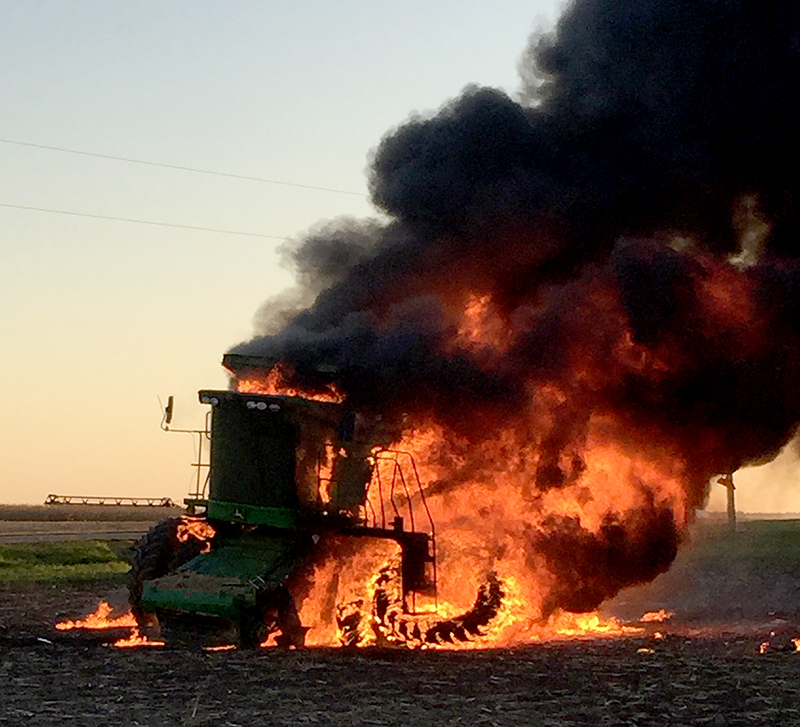This article was originally published by Purdue Agricultural Communications, October 2016. Revised and updated by the Purdue Agricultural Safety & Health Program, September 2020.
Harvest 2020 in Indiana and other Midwestern states is starting very dry! Much of Indiana is currently rated as “abnormally dry” or even “moderate drought” and very little if any precipitation is in the near-term forecast. Combine fires cost farmers millions of dollars in damages every harvest, and in dry years such as 2020, the potential for fires is even greater than normal. In fact, the Purdue Agricultural Safety & Health program has already received reports of combine fires in Indiana. As harvest ramps up, be proactive and prevent or reduce the chance of combine fires before they happen!!
Farmers should regularly inspect their combines’ machinery, fuel lines and electrical systems during harvest season to prevent fires, a Purdue Extension safety specialist says.
Harvest season brings a unique combination of risk factors that increases the risk of combine fires, said Bill Field, professor of agricultural and biological engineering. Dust kicked up during field operations and dry plant material from crops can clog or wrap around machinery, causing it to overheat. Other common hazards are electrical malfunctions, sparks from hitting rocks, loose or slipping belts and leaks in fuel or hydraulic lines.
Worn bearings or seals and blocked exhaust systems can cause overheating and sparks. Inspecting equipment at the end of the day can help prevent overheated components from catching fire during the night, Field said, and a hand-held thermal camera can help detect hot areas before they ignite.
Combine fires can be devastating, often resulting in the total loss of a vehicle and causing hundreds of thousands of dollars’ worth of property damage, says Purdue University farm safety expert Bill Field.

Combine fires can escalate in seconds, so it is critical for farmers to carry cellphones or two-way radios to call for help if a fire occurs, Purdue University farm safety expert Bill Field says. (Photo courtesy of Andrew Winger/Winger Farms)

Combine fires can be devastating, often resulting in the total loss of a vehicle and causing hundreds of thousands of dollars’ worth of property damage, says Purdue University farm safety expert Bill Field. (Photo courtesy of Andrew Winger/Winger Farms)
Some components of the combine’s electrical systems are also at higher risk of overheating, particularly parts like starter motors and heating and cooling systems that draw a heavy electrical load. “Fuses that blow regularly should be considered an important warning sign that a circuit is overheating somewhere,” Field said.
“Every fire involves three elements – an ignition source, fuel and oxygen. Removing one or more of these elements will prevent fire, so as you examine the combine, other agricultural machinery or a building, consider the potential for each element and where they are likely to come together to form a fire.”
In case a fire does start, farmers should always have a cellphone or two-way radio with them in the cab. Also, combines and other large units should have at least two 10-pound, type ABC fire extinguishers installed, Field recommended. These extinguishers should be inspected regularly to make sure the lock pin is intact, tamper seals are unbroken and the tank is still full.
A second line of defense is to have a tractor and disc on standby to create a firebreak around the combine, Field added. This can help keep the flames from spreading across the field or to neighboring properties.
Since insulated cabs may prevent operators from noticing smoke or flames until it is too late, combine fires can start without warning and quickly grow out of control, Field said.
“Even small leaks in a fuel or hydraulic system can cause a small fire to become a large one in seconds,” Field said. “For example, a leak causing diesel fuel to be sprayed into the engine compartment of a tractor or combine can cause the compartment temperature to go from a normal operating temperature to over 1,000 degrees Fahrenheit in seconds. Fires of that intensity are almost impossible to extinguish before the machine is destroyed.”
In addition to damaging or destroying the combine, other consequences may include crop loss, field fires spreading to adjoining properties, and operator injury or death.
“Ultimately, the only good fire is a contained one that keeps us warm,” said Field. “Keeping it that way in the field should be part of every farmer’s management plan this fall.”


